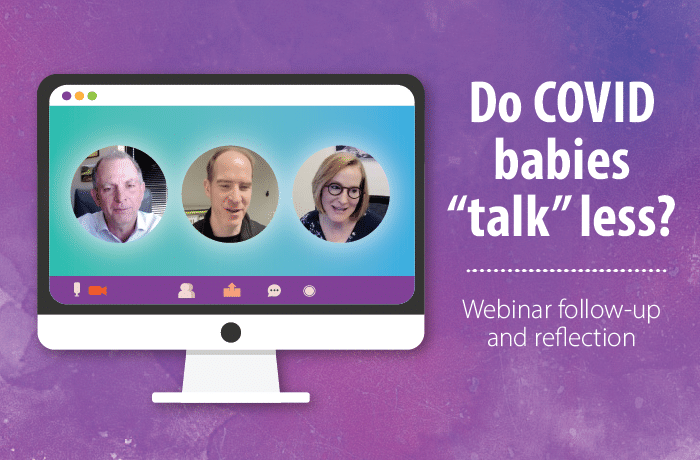Our recent webinar Do COVID babies “talk” less? featured data from Dr. Jill Gilkerson, chief research and evaluation officer at LENA, and Dr. Sean Deoni, associate professor of diagnostic imaging and piediatrics at Brown University, contrasting the early language experiences of children born before and after the start of the COVID-19 pandemic. In separate studies, both researchers used LENA technology to measure children’s language environments and found that the children born after the start of COVID vocalized less and experienced fewer conversational turns than their peers born before the pandemic. Infants, male babies, and children from lower SES families saw the steepest declines.
The data received a lot of attention, and we are grateful for the thoughtful engagement and commentary from the nearly 600 attendees who joined us for the live discussion, as well as hundreds more who tuned in to stream the recording. More than 20 countries were represented, underscoring the widespread nature of the concern about challenges this generation of children may be facing.
Accepting where we are now
Despite the mounting research and news coverage, understanding and acceptance of pandemic-related developmental concerns is far from universal. One theme that stood out from our attendees was that many people felt their concerns have not been acknowledged and found that the data presented validated what they have personally experienced:
- “There is a resistance to acknowledge that these kids are impacted. I have a 2-year-old and I have people tell me ALL THE TIME, ‘Oh, he will be fine, it’s not a big deal, it’s not because of COVID that he’s resistant to talking,’ etc., and they dismiss my concerns. This comes from educators, doctors, family members, etc. If I’m experiencing this, I know others are. How do we get society to acknowledge this is a thing?”
Amber Klingner, All Hands Raised, Portland, Oregon
- “I work in [Early Intervention] in the North East and we have evaluated over 9,000 children since COVID started. Administrators were concerned about the higher percentage of eligible children and questioned whether virtual evals were reliable. Our experienced evaluators were convinced the results were valid. We started to see that pattern very early on.”
Lee Fancher, early interventionist
- “In children’s audiology we are seeing 2-year-olds with no speech who do not respond to simple sounds – only theme tunes.”
Josephine Marriage, director of Children’s Hearing and Amplification Resource (CHEAR), UK
- “As an early interventionist, I see the social emotional area of babies and toddlers so affected that although there are speech concerns, I have to coach families/caregivers on the social area before we can address the communication concerns.”
Laura Heinze, early intervention teacher
In response to Laura Heinze’s comment, we’d like to highlight a 2021 study published in Developmental Science by Dr. Esteban Gomez Muzzio and his team in Chile. That paper established a causal link between conversational turn-taking and children’s socioemotional development. We hope to see further research on how changes in interaction during the pandemic may be linked to socioemotional outcomes like the ones Laura describes.
Why are we seeing less talk?
Many attendees were interested in why these children are talking less and which specific factors may be correlated with decreased interaction. The most frequently asked about: caregiver stress, screen time and media consumption, COVID (gestational COVID and vaccination status), and masks.
Dr. Deoni addressed several of these factors directly within his data and in the webinar q&a. Parents in his study, for example, did not report increased stress after the start of the pandemic. He noted that lack of pre-post differences in stress may be related to bias in the sample, since families were pre-recruited.
“These were all primarily pre-enrolled parents but yes, the maternal stress finding is interesting, and I think means that these are less worried families who were still willing to come into the imaging center,” he said in the chat.
Regarding the role of COVID itself, none of the children in Dr. Deoni’s sample were known to have COVID (though some of their caregivers did). LENA did not collect that data for Dr. Gilkerson’s study. On this question though, we suggest referring to a study from Colombia looking at developmental impacts related to exposure to COVID in utero. The study concluded that developmental effects were related to the pandemic itself rather than direct exposure. These findings also support the need for longer-term monitoring to continue to evaluate the pandemic’s potential developmental impacts.
Many feel that screen time and media use are likely to be playing a role in decreased interaction and asked to what extent those factors were looked at. LENA technology monitors electronic sound, but is device agnostic, putting any sound that comes from an electronic speaker into the ‘TV/Electronic sound’ category. Dr. Deoni’s data did show slight increases in electronic sound, but noted that the decreases in adult words, infant vocalizations, and conversational turns were more significant.
There were two key questions that surfaced related to masks. The first was whether interacting with adults outside the home generally or in child care specifically might be impacting child development. On this point, Dr. Gilkerson noted that LENA technology may be able to give us more insight into this question in future research.
“The data we are presenting was collected in the home, where masks were not a factor. But I do think LENA data can help us learn more about the effects of masking, since it provides a crucial measure from the point of view of each child,” she said.
The second was whether the examiners administering the assessments in Dr. Deoni’s study were masked, and therefore potentially biasing the children’s performance on the assessments.
“Masks are interesting. I think it’s informative that a group at Columbia found the same results we did but using a parent reported measure of child development, so somewhat minimizes the idea that masks were playing a role,” he noted in the chat.
While it’s likely that any or all of these elements combined may be playing some role in the changes we are seeing, Dr. Gilkerson noted that there is likely to be high variance between families.
“We’ve gotten a lot of questions on why we are seeing decreased caregiver-child interactions. Honestly, I think there are so many different potential factors in play, and those vary from family to family. I think rather than trying to pinpoint a specific cause, we need to focus on increasing investment in initiatives that support young children at all levels,” she said.
This data is alarming. What can we do now?
Many participants chimed in to ask how to respond to this data: How do we support families? What do supportive policies look like?
In the very near term, Dr. Deoni’s advice is hard to beat: “Love your children.”
We also think it’s important to spread the word and build awareness of what’s happening. Sharing recent news articles from The 74, EdWeek, and Discover magazine with your network and on social media is a great way to start. You can also share the link to stream the webinar on demand.
We also offer resources that can be shared with families and caregivers looking for information on ways to increase interactions with their children:
- LENA’s research-based 14 Talking Tips
- “Your child’s brain needs talk” infographic
- Our social media toolkit with bite-sized graphics and captions, ready to post
Longer-term and on a policy level, there is a lot of work to be done. But there is reason for hope, too. Dr. Gilkerson reported results showing that LENA programs have helped caregivers increase positive and nourishing interactions.
“We know that interacting with young children is an absolutely critical component of their development. That isn’t happening as much because children are vocalizing less, so we need to increase our support for families so they can strengthen their caregiving in the home,” she said.
“I also think this emphasizes that child care and early childhood education must be considered part of a larger web. Family-focused support organizations, child care systems, school districts, health care institutions and other government and public entities — we must all work together to increase our support for families so they, in turn, can strengthen their caregiving in the home.”
LENA programs put research into action
LENA puts this and other research into action through feedback-based programs for parents and teachers. These programs, currently implemented by organizations around the world, are designed to increase adult-child conversational turns and have already benefited thousands of children:
- LENA Grow, offering job-embedded professional development for early childhood teachers and family child care providers.
- LENA Start, strengthening families with parent-group classes.
Learn more about bringing a LENA program to your community by clicking the button below:








